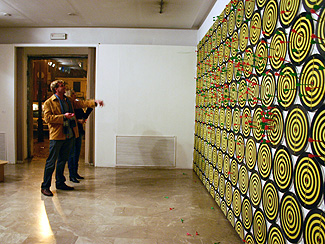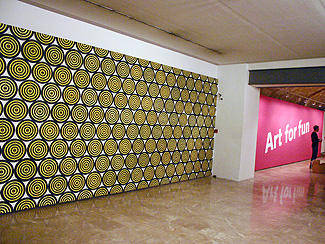Art for fun Participatin artists I’m like a living abstract painting There are many different kinds of collections. Men and women buy and store all kinds of things although there is no unanimous answer to why this happens. If I tried to find an explanation to what seems to offer none at all, I could argue that Dahlgren is one of those artists who considers play a vital attitude and, therefore, creative. He is always searching for abstraction which, in fact, contains reality. By that I don’t mean ontological theories, but actually pictorial abstraction which through design and urban furniture above all dominates the cities where we live. Another of his collections consists of photographs that he himself takes of abstract designs that on a daily basis go unnoticed. There are photographs of traffic signs, aeroplanes and models in underwear – striped of course – very ugly chairs.. in short, anything that catches his attention because of its design or abstract paintings. I, the world, things, life was presented for the very first time in the Norrköpings Konstmuseum in 2004. It is an interactive installation but, as we have already been able to discern, Jacob is a painter. All his works have more in common with painting – abstract in particular – than with installation techniques. The work consists of an indeterminate number of dartboards, although quite a few must have been used. But obviously when you place a thousand dartboards all together and next to each other on a wall, the result is a composition of colours and shapes rather than a great number of dartboards, which is a painting itself, irrespective of whether paint has been used to colour the t-shirts. Besides, his historical role models are clearly painters. Dahlgren is a transverse artist, he intertwines a great number of references and quotes of the history of modern art in a most extraordinary fashion, above al in his latest manifestations; in this case we are referring to op art. However, he always resorts do disposing of its original content in order to take in to another sphere and put in into his own context. To a certain extent his procedure sums up the advance from Modernism to Post-Modernism. I like to form an image of this passage by taking into account the change of attitude experienced in visitors who attend these openings. From a serious and profound attitude in the opening in the modern age to a smiling attitude of the visitor and having to decipher the game that the artist proposes and discovering what lies behind this play activity. In front of this painting made of dartboards, there is a drawer full of darts. The visitor is invited to play darts. He becomes aware in a few seconds that it is he who is forming the final composition. Dahlgren reinvents action painting. He does away with a tedious pathos and transforms it into something enjoyable and participative, but no less reflective when the visitor, now an artist confronts the question; what happened to modern utopia? The same revisionist approach can be found in other works like Heaven is a place on earth, 2006, in which he substitutes the typical plaques of the minimalist Carl André for bathroom scales in different colours. Again it is the multiplication of a consumer good, where colour plays an important role. Another important concept in Dahlgren’s work is what is known as ready made. As we can see, his works are made of already existing industrial objects and made for massive consumption. It is the profusion of an abject that reaches absurd levels which transforms them. In Krakow 2002, he uses yoghurt containers, in The wonderful world of abstraction, 2006, he uses silk ribbons and in Colour reading and contexture, 2005, any product he could lay his hands on with an interesting colour. This latter work is one of the most powerful installations, which occupied 1.100 x 1.100 x 200 cm at the Malmö Konsthall. His most complete work may bi, however, the best pictorial work that I have seen for a long time, Signs d’abstraction. He made de piece in a shopping centre in Stockholm in 2005. For this work three hundred people wore striped t-shirts – obviously all from his collection – and walked around the shopping centre in a leisurely manner all day. In this way he transformed the shopping centre into the support of a great living abstract painting. I must state that concerning this kind of pieces I consider Dahlgren to be the most innovative abstract artist I have come across in years. He succeeds in finding an unexpected twist to the tremendous impasse which painting seemed to have submerged over the last few years. |
|
 |
 |
|
|